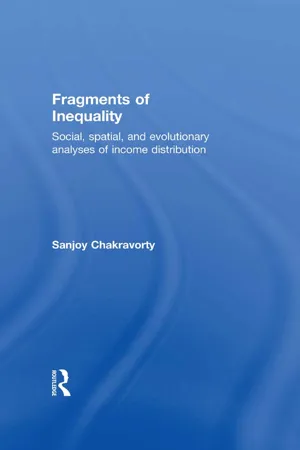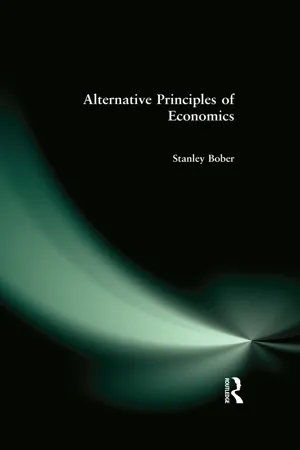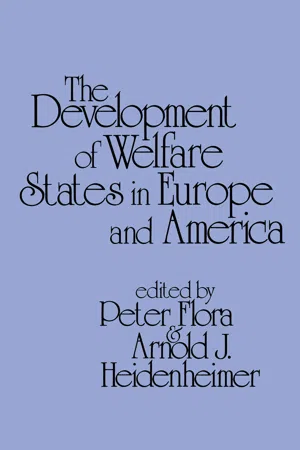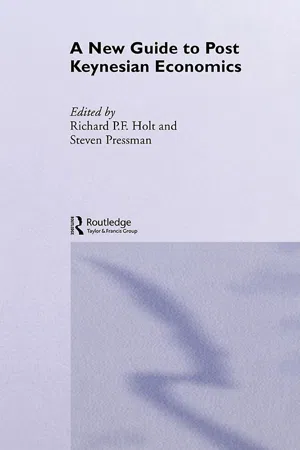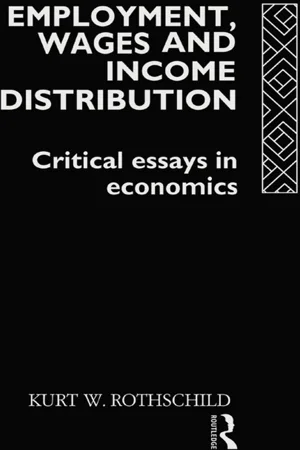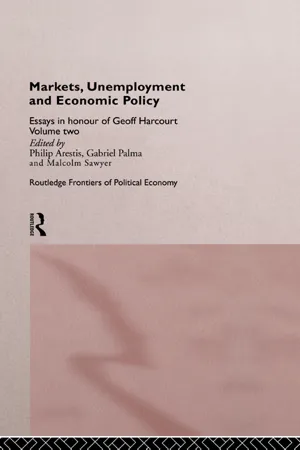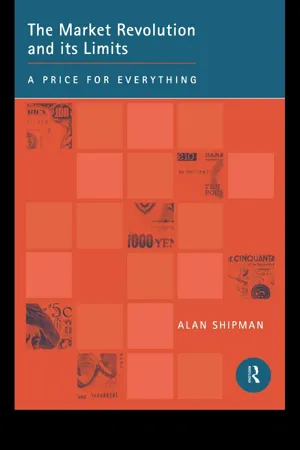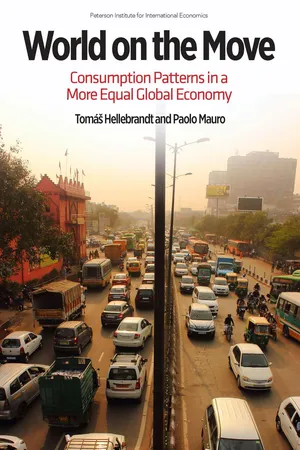Economics
Market Distribution of Income
Market distribution of income refers to the way in which income is divided among individuals or households within a market economy. It reflects the unequal distribution of income across different segments of the population, often resulting in income inequality. This distribution is influenced by factors such as wages, profits, and government policies.
Written by Perlego with AI-assistance
Related key terms
11 Key excerpts on "Market Distribution of Income"
- eBook - ePub
Fragments of Inequality
Social, Spatial and Evolutionary Analyses of Income Distribution
- Sanjoy Chakravorty(Author)
- 2014(Publication Date)
- Routledge(Publisher)
3ECONOMIC THEORY AND INCOME DISTRIBUTIONInequality is a very large subject. Income distribution, which is the framework used in economics to study inequality, is itself a very large subject. David Ricardo, one of the pioneers of the discipline, wrote to Thomas Malthus: “Political economy you think is an inquiry into the nature and causes of wealth. I think it should rather be called an inquiry into the laws which determine the division of the produce of industry among the classes who concur in its formation” (quoted in Ferguson and Nell 1972, 437). Despite ups and downs in interest in income distribution, the subject is so large that small subsections of it can fill entire bookshelves. For instance, the Luxembourg Income Study (LIS) referred to in Chapter 2 , which focuses almost entirely on OECD countries, has, by itself, produced more than 350 substantial working papers. There are hundreds of papers on the measurement of inequality in income distributions. Scores of papers and books focus on a single idea in distribution, the Kuznets hypothesis (more on which later in this chapter). All this is in the literature in economics alone. Inequality is also studied by sociologists. They focus on social inequality, social classes, and stratification, which together form perhaps the single largest subject area in the discipline, which has a literature that may be as voluminous as in economics.Trying to summarize this vast literature while doing justice to all its important strands is an enterprise beyond my ability and well beyond the objectives of this chapter. Had there been some consensus, or even convergence, in the literature, the task might have been manageable. Part of the reason this literature is so vast is that there is no generally accepted theory of income distribution. One fundamental schism divides scholars. This schism is not disciplinary. It is not economics vs. sociology. Rather, within every social science discipline there is fundamental divide, which I will call a metatheory divide.1 This concerns basic beliefs about human nature, social institutions, and units of analysis. Chapter 1 outlined this divide in terms of a tripartite division of interests —self interest, group interest, and territorial interest—which is another way of saying that theories are either individualistic or they are not. (Another detailed treatment of the metatheory divide is presented in Chapter 4 - eBook - ePub
Ten Millionaires and Ten Million Beggars
A Study of Income Distribution and Development in Kenya
- Mwangi Wa. Githinji(Author)
- 2019(Publication Date)
- Routledge(Publisher)
2 Dualism and Income Distribution in EconomicsIntroduction
The study of income distribution has been a mainstay in the study of economics from the time of the physiocrats to the present day. Adam Smith's Wealth of Nations, written shortly after the peak of the physiocrats, became the reference point, as it did for many branches of economics, for a theoretical underpinning of studies related to income distribution. Why is research on income distribution of importance to economists? It is of course interesting, in its own right as part of a general description of an economy. More importantly though are the implications that it may have. There are four important implications that we can immediately identify.The first of these is that the level of income of an individual is one of the indicators of the well being of the individual. Given the average income of a country, the distribution of income provides some indication of how well off are different sectors of the population. The second implication is related to the growth of the economy. Growth is dependent upon investment. Whether investment occurs and at what rate, depends to some extent on who controls the available funds for investment. Studies of income distribution therefore have often attempted to identify who controls these funds. The third relationship is an extension of the second. The distribution of income helps to determine who controls savings and investment, and it is also related to the distribution of wealth. Most social scientists agree that there is a causal relationship between wealth and power. If this is correct then a study of the distribution of income may not only shed light on the process of growth, but also on the pattern of development that a particular economy may undergo. Different income distributions will produce different demands for goods and services and hence generate different patterns of investment. Different patterns of growth result from these investment decisions. In less industrialised countries, where the rate and pattern of growth is of great importance to policy makers, examination of income distribution may give an indication of how the economy is likely to develop. - eBook - ePub
- Stanley Bober(Author)
- 2016(Publication Date)
- Routledge(Publisher)
Then the decision entered into by firms regarding their technique of production will feed back to households in the form of different levels of earned income, as each household possesses and “sells” different quantities of those “capital” and labor inputs. The point is that households trade the services of those productive inputs that they possess in specific factor markets, which determines their prices, which then become costs to the producing units. The latter, to reiterate, then considers these costs in conjunction with the particular technical requirements needed of these inputs to determine what combination of capital and labor inputs to employ. And this gives rise to differences in earned income across the population, which can be aggregated into an overall income distribution picture with regard to the earnings of labor and that of capital.We are going to consider the basic mechanics involved for such a market-determined income distribution in order to have a clear base from which to mount a critique of this conventional approach and propose an alternative understanding, similar to the way we handled consumer-demand theory.The essential point then for the orthodox explanation is that the distribution of income is determined by the price at which the household (or each individual) can sell, in the competitive marketplace, the services of the factors of production which it possesses. The whole matter of distribution is simply a facet of price theory; that is, one derives a theory of distribution as incidental to the pricing mechanics, in that distribution is determined by conditions of exchange. There is no need then for a particular analysis or understanding of the “reward” to each factor of production; one need not relate or justify the payment to an input as stemming from its particular role in the production process and as an outgrowth of the social and technical relationships between people who reside behind the faceless term of “inputs” or “factors.” In conventional theory the distribution of the output does not relate to the existence of social classes in society with an inherent conflict between them that is grounded in a historical context. Indeed, since all factor incomes are seen to flow from the same explanatory pricing principle, it is but a short step to consider the relationship between those whose income is composed of the reward to capital (interest and profits) and those whose income is composed of the reward to labor (wages) as an essentially harmonious one. Each makes a distinct contribution to production and receives an appropriate market-determined reward. Of course, households may receive more than one classification of income, but as we will be looking at the mechanics of the distribution to each input, it may be clearer to think of the income from capital and that from labor accruing to different households—designating the former as capitalists and the latter as workers. And what is taken as underlying this pricing approach is, to reiterate, the cooperative spirit of these different households. If there is an antagonism between them (e.g., a worker strike) it is merely a form of competing with one another as to who should get more of the value that they conceive of having jointly created. There is, one might say, a double harmony between the labor and capital inputs; they cooperate in the act of production, and in distribution their struggle is merely the manifestation of an underlying community of interest to bring about a higher level of output. - Peter Flora(Author)
- 2017(Publication Date)
- Routledge(Publisher)
Part FourEconomic Equality: The Distribution of Incomes
Passage contains an image
Chapter 6
The Historical Development of Income Inequality in Western Europe and the United States
Franz KrausI. Problems in Examining Income Inequality
A. Defining Income Distribution
Today material welfare is much less dependent on market incomes or rewards for labor and property in the production process than in earlier times. Direct and indirect taxes, transfer payments, and the provision of public services—all consequences of the growth of the welfare state—have clearly weakened the importance of wages and assets in determining economic status. To analyze income inequality with respect to the development of the welfare state, we must distinguish between a producer inequality that simply refers to market incomes, and a consumer inequality that reflects the final distribution of income after taxes, transfer payments and the consumption of public goods have been taken into account.To assess income inequality from a comparative and historical perspective, we must ask how these two fundamental aspects of economic inequality differ from each other, how they vary between countries, and how they have changed over time. Furthermore, we want to examine the relationships between producer inequality and consumer inequality: who finances, and to what extent, public expenditures, and who benefits, and to what extent, from transfer payments and public goods?Because of the shortcomings of available sources, particularly for previous periods, quantitative assessment of the extent men benefit from public goods is most difficult.1 Similarly it is difficult to estimate the impact of public expenditures on income inequality through changes in factor demand and supply, such as the extension of public education or the civil service. However, if we leave aside these more qualitative questions, we can still learn much from analyzing the successive steps by which producer inequality is transformed into consumer inequality. Figure 6.1 2 provides a simplified overview3- eBook - ePub
- Richard P. F. Holt, Steven Pressman(Authors)
- 2001(Publication Date)
- Routledge(Publisher)
At the same time, the literature is vulnerable to a Post Keynesian critique. To make such a critique persuasive requires a clear theoretical restatement, going beyond the usual appeal to institutions, politics, and history. But it also requires a persuasive empirical substantiation, one capable of accounting for the movement of inequality through time and in different national settings. Post Keynesians need to show that the personal distribution of income is linked to the flow of economic profits as a share of national income, and therefore to the spending decisions of capitalists and their macroeconomic ramifications. They need to show this, not only for the US, but for a wide range of countries. The Post Keynesian theory of income distribution is not specific to the US.For this we need more and better data, particularly better measures of economic inequality through time, so that the relationship between inequality and macroeconomic phenomena can be tracked. A macroeconomic theory of distribution requires macroeconomic measures of distribution. Fortunately, this condition can be met. The requisite information is available in the historical record, over long time spans and for many countries. Until recently, however, its potential for this purpose has rarely been recognized and almost never exploited (see Galbraith and Berner, 2001).Toward a macroeconomic theory of personal income distribution
Consider a simple setting: an economy with one production factor (labor), and firms with identical rising marginal production costs, but distinct markets. One firm faces a competitive, perfectly elastic demand curve and prices at marginal cost. Another firm faces a downward-sloping demand curve and sets output so that marginal revenue equals marginal cost, with price taken from the corresponding point on the demand function [as first stipulated by Joan Robinson (1933)]. The second firm enjoys a degree of monopoly equal to the inverse of the elasticity of the demand function, per Abba Lerner (1934), and a monopoly return per unit equal to the difference between price and marginal cost. Since this model has no capital, there is no profit either. The monopoly return must be distributed to the sole factor of production, namely labor: it is a firm-specific labor rent. The distribution of income therefore depends entirely on the relative degree of monopoly power. - eBook - ePub
Cornell Studies in Political Economy
Social Europe vs. Liberal America
- Jonas Pontusson(Author)
- 2006(Publication Date)
- Cornell University Press(Publisher)
I begin by looking at aggregate data on the distribution of disposable household income and then hone in on the distribution of gross earnings among working-age households. As we shall see, gross earnings became more unevenly distributed in all but one of the OECD countries for which we have time series data for the 1980s and 1990s (the Netherlands being the only exception), and the growth of earnings inequality provides a very strong predictor of the growth of disposable income inequality on a cross-national basis. To some extent, taxation and social spending have offset increases in earnings inequality, but redistribution by governments has failed to keep up with inegalitarian market forces. More tentatively, I shall argue that labor market dynamics are key to the general tendency for inequality to grow or, in other words, that changes in the distribution of wealth and financial market dynamics are of secondary importance.To explain patterns of earnings inequality growth among working-age households, we must attend not only to changes in the distribution of wages among employed workers but also to changes in the distribution of employment across households. We observe in the United States and some other countries large increases in wage inequality over the 1980s and 1990s, but the effects of these increases for the distribution of household earnings were partly offset by increased employment among low-income households. In other countries, wage differentials remained more or less stable, but low-income households lost employment relative to high-income households. Access to employment thus emerges as a crucial source of inequality in the following analysis. Leaving the question of explaining comparative employment performance for subsequent chapters, I will explore the reasons why wage inequality has increased more in some countries than in others, emphasizing the role of political-institutional factors, and briefly address the relationship between wage inequality and productivity in the final sections of this chapter.THE DISTRIBUTION OF HOUSEHOLD INCOME
Taken directly from The State of Working America 2002/2003, a comprehensive report by Lawrence Mishel, Jared Bernstein, and Heather Boushey, figure 3.1 illustrates the growth of inequality in the United States since the mid-1970s and the sharp departure that this trajectory represents relative to the 1950s and 1960s. With American families ranked according to income and then divided into quintiles, the top panel shows the cumulative growth of real gross family income—that is to say, inflation-adjusted income before taxes—for each quintile from 1947 to 1973. The bottom panel shows the corresponding figures for the period from 1973 to 2000. According to the data presented in figure 3.1 - eBook - ePub
Employment, Wages and Income Distribution
Critical essays in Economics
- Kurt W Rothschild(Author)
- 2006(Publication Date)
- Routledge(Publisher)
But before turning to these questions I want to draw attention to the extreme complexity of the subject which burdens all discussions in this field. It has already been pointed out that neither economists nor moralists are of one opinion about the mechanisms and norms of the distribution process. In addition, the distribution itself is a multi-faced phenomenon which can be viewed from different angles. Should we deal with personal or household incomes, with income and/or wealth, should we include other factors like working conditions, opportunities, access to public goods or even climate (in international comparisons)? Even when one has agreed on one definition, say personal incomes, there still remain difficult questions regarding the measurement of equality and inequality which affect the evaluation of different distributions.All these questions, which are the subject of many discussions, will not be treated here. They must be discussed within the economic and ethical communities in order to arrive at clear definitions and alternatives which will ease the path towards a more precise communication. Since I am only concerned with the essentials of the economic-ethical controversy I can restrict myself to the central question of the distribution of net incomes (incomes after tax and including transfers) and I shall assume that expressions like ‘more equality’, ‘less equality’, ‘levelling’, etc. are self-explaining and need not be further defined. The centre of our considerations is occupied by the economic-ethical dilemma ‘efficiency vs. justice’.Let us begin with the factual aspects of the problem. The question is whether it is possible (or impossible) to combine the aim of economic efficiency and as big an output as possible with ethical ideas about a just distribution. The valuation criteria which we shall discuss later become relevant as soon as an ideal combination of the two aims proves to be unattainable and a ‘proper’ trade-off between them has to be found. The factual question becomes topical in economic-ethical discussions when the moral philosophers are not contented to discuss ‘ideal’ distributions in abstracto - eBook - ePub
- Philip Arestis, Gabriel Palma, Malcolm Sawyer(Authors)
- 2005(Publication Date)
- Routledge(Publisher)
17MACROECONOMICS AND THE DISTRIBUTION OF INCOME1Tony AtkinsonGeoff Harcourt as an economist has spent much of his life thinking about, and teaching us about, macroeconomics; Geoff as a citizen has been much concerned about the personal distribution of incomes. The subject of this chapter is the relation between these two subjects – or, more accurately, the lack of relation. I must confess to being puzzled, as an outsider to macroeconomics, as to why the factor distribution of income has ceased to be central to macroeconomics, and why there has ceased to be any direct connection between modern macroeconomics and my own particular field of interest – the distribution of personal income.TODAY’S NEGLECT OF FACTOR SHARESThe subject of the macroeconomics of income distribution – that is, the distribution of national income between wages, profits and rent – seems now to be little discussed. The share of wages, and whether it is constant or rising or falling, was once a central topic in macroeconomics. As a student in the early 1960s, I listened to debates about different theories of distribution, debates in which Geoff took a vigorous part. In fact the macroeconomic theory of distribution seemed to dominate the field of income distribution.Now, thirty years later, things seem to have changed, and factor shares are not essential to macroeconomics. For instance, the widely used textbook, Macroeconomics, by Mankiw (1994) includes in its inside covers eight graphs of key statistics on the United States’ economy from 1900 to the present, but these do not include the share of wages or profits in national income. The share of labour income is given later in the text (1994: 75), but the factor share figures are not regarded as of central importance.Factor shares are typically introduced in connection with the Cobb-Douglas production function; and the main information which students of macroeconomics appear to be given on factor shares is that they are constant over time. According to Mankiw, ‘Labor income has remained about 0.7 of total income over a long period of time. This approximate constancy of factor shares is evidence for the Cobb-Douglas production function’ (1994: 75). Hall and Taylor, in their text with the same title, similarly state of factor shares that These relative shares are fairly stable from year to year’ (1993: 48). - Nancy Baster(Author)
- 2018(Publication Date)
- Routledge(Publisher)
4 Seen in this light, it was understandable that economists should believe that distributional problems were largely self-correcting and could therefore be safely ignored. The best remedy for maldistribution was growth; and to try to interfere with distribution would certainly be to jeopardize growth. Thus Professor Harry Johnson:The remedies for the main fault which can be found with the use of the market mechanism, its undesirable social effects, are luxuries which underdeveloped countries cannot afford to indulge in if they are really serious about attaining a high rate of development. In particular, there is likely to be a conflict between rapid growth and an equitable distribution of income; and a poor country anxious to develop would probably be well advised not to worry too much about the distribution of income [Johnson, 1958]. 5Put in that general form with all the crucial parameters unspecified, the assumption is open to serious challenge. What precisely is meant by an improvement in income distribution? A statistical definition would be a fall in the Gini index of concentration, but that is theoretically consistent with deepening poverty of the lowest decile or even lowest two deciles. This possibility formally depends upon the relative size of the population of the income deciles and the dispersion of incomes in the remaining deciles. Broadly, the smaller the proportion of the whole population in the lowest income decile and the lower the dispersion of income in the three upper deciles, the more possible it is that a given improvement in the distribution of income, as measured for instance by a fall in the Gini index of concentration, is consistent with a deterioration in the income accruing to the lowest decile. Now it is true that these conditions are rarely fulfilled. The size of the lowest income deciles is usually very large: indeed the lowest quartile of income can be received by as high a proportion as 85 per cent of the whole population. Similarly the dispersion of incomes amongst the rest of the population tends to be marked.- eBook - ePub
The Market Revolution and its Limits
A Price for Everything
- Alan Shipman(Author)
- 2002(Publication Date)
- Routledge(Publisher)
The high transmissibility of relative social position across generations, and difficulty of making long-range upward moves, suggests imperfections in the market for ‘cultural capital’ (status, social networking, self-esteem) as well as physical and human capital. As well as handing down their concentrations of property, those currently high up the income distribution can buy educational and presentational advantages for their close relatives which increase their chances of entering the distribution high up. But these advantage-preserving mechanisms seem at least as strong in economies which have yet to embrace the market as an organising principle, or have tried to replace it. To the extent that markets ignore cultural characteristics in favour of ability to pay, and relate this at least in part to personal enterprise and effort, they can be seen as offering at least the possibility for high rates of mobility, even if there are many imperfections in other capital markets still to overcome.10.3.5 Attacking the alternatives 1: the ‘inequality surplus’
The belief that income inequality promotes innovation and growth, so that even the relatively worst off find their absolute incomes growing faster than if relative incomes were kept more equal, appears deeply ingrained in societies which view themselves as structured around market transaction. Even the ‘radical’ distributive justice theory of Rawls (1971), who takes the welfare of the (absolutely) worst-off as the key meaure of social justice, assumes an ‘inequality surplus’ that will justify departures from income equality, even if income (or the ability to earn it) is arbitrarily assigned. Historical analyses of industrialisation in western Europe and North America have tended to conclude that inequality had to rise before wider material-goods availability could ‘trickle down’ to raise the majority living standard. The ‘supply-sider’ prescription for another burst of post-industrial growth tended to argue, without apparent irony, that the rich needed to get higher rewards (through a cut in redistributive income tax) before they would apply their skills and innovate to enrich the economy, whereas the same incentives for the poor required their redistributive benefits and minimum wages to be cut. - eBook - ePub
World on the Move
Consumption Patterns in a More Equal Global Economy
- Paolo Mauro, Tomas Hellebrandt, Jan Zilinsky(Authors)
- 2016(Publication Date)
3Measuring Income Distribution within CountriesThe test of our progress is not whether we add more to the abundance of those who have much; it is whether we provide enough for those who have too little.—Franklin D. RooseveltIn many countries, large and growing domestic income disparities have pushed their way to the top of the list of citizens’ concerns. To many people, the growing gap between the haves and the have-nots indicates a failure of the political and economic system to treat all citizens with equal concern and respect. The moral issue is reason enough to pay close attention to how inequality is measured, how it compares across countries, and how it evolves over time.There is also a practical reason to focus on the measurement of inequality. Unpacking the detail hiding behind macroeconomic measures of national well-being—focusing on people rather than countries—requires information on how living standards are distributed among a country’s citizens. Measuring inequality within countries is crucial for estimating global inequality. Moreover, estimates of domestic distributions and judgments about how they are likely to evolve in the future will influence the projected evolution of the gap between the global rich and the global poor, as well as the global consumption of various categories of goods and services.This chapter examines how economists measure inequality. It discusses the challenges posed by survey data and explains a novel method of reconciling surveys with national account measures of household consumption. This method results in higher estimates of inequality within countries than indicated by survey data alone. The chapter then discusses recent trends in inequality within countries and the cross-country relationship between inequality and the level of development. The results can be used to inform projections of within-country inequality into the future.
Index pages curate the most relevant extracts from our library of academic textbooks. They’ve been created using an in-house natural language model (NLM), each adding context and meaning to key research topics.
